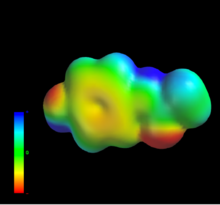Polar surface area

Electrical potential surface of paracetamol showing polar areas in red and blue
The polar surface area (PSA) or topological polar surface area (TPSA) of a molecule is defined as the surface sum over all polar atoms or molecules, primarily oxygen and nitrogen, also including their attached hydrogen atoms.
PSA is a commonly used medicinal chemistry metric for the optimization of a drug's ability to permeate cells. Molecules with a polar surface area of greater than 140 angstroms squared (Å2) tend to be poor at permeating cell membranes.[1] For molecules to penetrate the blood–brain barrier (and thus act on receptors in the central nervous system), a PSA less than 90 Å2 is usually needed.[2]
See also[]
References[]
- ^ Pajouhesh H, Lenz GR (Oct 2005). "Medicinal Chemical Properties of Successful Central Nervous System Drugs". NeuroRx. 2 (4): 541–553. doi:10.1602/neurorx.2.4.541. PMC 1201314. PMID 16489364.
- ^ Hitchcock SA, Pennington LD (May 2006). "Structure - Brain Exposure Relationships". J. Med. Chem. 49 (26): 7559–7583. doi:10.1021/jm060642i. PMID 17181137.
This article includes a list of general references, but it lacks sufficient corresponding inline citations. (December 2017) |
- Pajouhesh, Hassan; Lenz, George R (2005). "Medicinal chemical properties of successful central nervous system drugs". NeuroRx. 2 (4): 541–553. doi:10.1602/neurorx.2.4.541. PMC 1201314. PMID 16489364.
- Clark, David E (1999). "Rapid calculation of polar molecular surface area and its application to the prediction of transport phenomena. 1. Prediction of intestinal absorption". Journal of Pharmaceutical Sciences. 88 (8): 807–14. doi:10.1021/js9804011. PMID 10430547.
- Palm, Katrin; Stenberg, Patric; Luthman, Kristina; Artursson1, Per (1997). "Polar molecular surface properties predict the intestinal absorption of drugs in humans". Pharmaceutical Research. 14 (5): 568–71. doi:10.1023/A:1012188625088. PMID 9165525. S2CID 7178582.
- Ertl, Peter; Rohde, Bernhard; Selzer, Paul (2000). "Fast Calculation of Molecular Polar Surface Area as a Sum of Fragment-Based Contributions and Its Application to the Prediction of Drug Transport Properties". Journal of Medicinal Chemistry. 43 (20): 3714–3717. doi:10.1021/jm000942e. PMID 11020286.
- Ertl, P. Polar Surface Area, in Molecular Drug Properties, R. Mannhold (ed), Wiley-VCH, pp. 111–126, 2007
- Shityakov, Sergey; Neuhaus, Winfried; Dandekar, Thomas; Förster, Carola (2013). "Analysing molecular polar surface descriptors to predict blood-brain barrier permeation". International Journal of Computational Biology and Drug Design. 6 (1–2): 146–56. doi:10.1504/IJCBDD.2013.052195. PMID 23428480.
External links[]
Categories:
- Cheminformatics
- Medicinal chemistry
- Chemistry stubs
- Computer science stubs